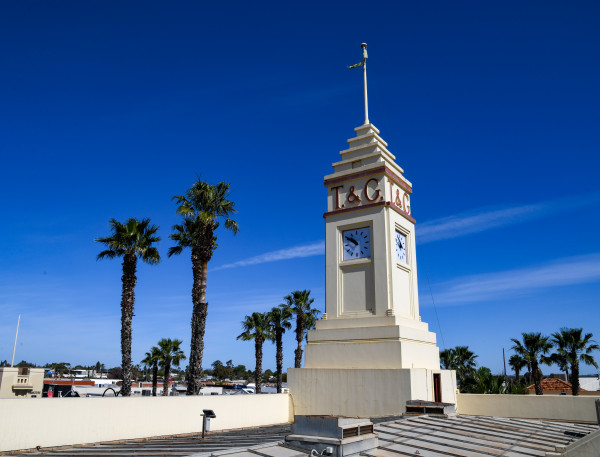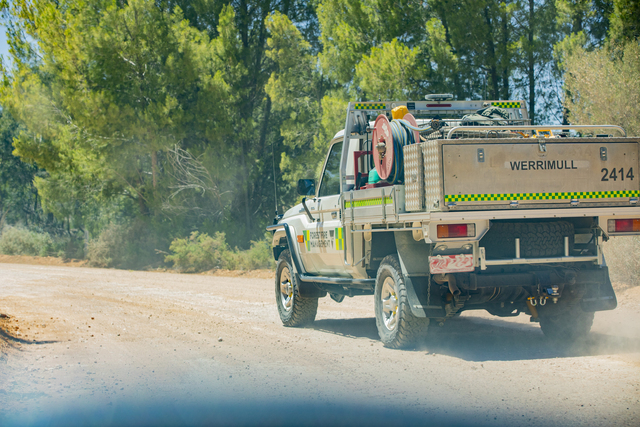IF you’ve ever kissed a complete stranger under the T&G clock, you probably date to a time when there was no Langtree Mall and no air-conditioned shopping centre out on the edge of town, and the art deco tower was the undisputed centre of the city.
Before there was a palm-planted roundabout at Eighth and Langtree, that’s where Mildura people would gather to party in the new year, with beers and champagne flowing, music playing and much opportunistic “pashing”, as the clock above ticked past midnight.
Those new years are just old memories now, but the T&G clock keeps ticking, tirelessly marking each moment in a city’s history as it has since 1937. Tens of thousands of locals and visitors have used it as a landmark and meeting place and, if you were born and raised here, it might have been the first “skyscraper” you ever saw. And you also might have wondered, as kids will imaginatively do, what mysteries might be hidden in that tower. Few have seen inside, but Sunraysia Daily recently toured the building, these days owned by retired farmer Ralph Tassone, and here’s what we found.
Getting to the clock itself is a climbing challenge of steps, ladders and tiny manholes, but it starts off in style. Past the iron gates and glass double doors on Eighth Street, a 1930s staircase covered in red carpet leads to the second floor, some of which is largely original and leased as business premises, and part of which is under renovation. That section used to house radio station 3MA, now River 1467, but the studio fittings are long gone. The radio rooms have been stripped back for leasing as modern offices, but what does remain is the T&G-branded hallway flooring, retained as a nod to the site’s history.
T&G, incidentally, stands for Temperance and General, the name of one of Australia’s biggest insurance companies until it was merged with another business in the 1980s. It was founded in Victoria in 1876 and its later success led to an unusual and prolific branding campaign, which involved the construction of 20 near-matching buildings across Australia and New Zealand. Mildura’s tower was one of those, although it was not built from scratch. The tower was erected in 1937 above what was known as the Zimmer Building, a commercial address of shops and offices which had been on the site since 1917 and acquired by T&G in 1936.
From the second floor a narrow service stairway, purely functional and yet ornately decorated with a Wunderlich pressed-metal ceiling, opens to the roof and views across the city’s centre. A boardwalk leads to a hatch-like door at the base of the northeast side of the clock tower, which cannot be seen from the street. Although an anteroom beyond it seems to have no obvious practical purpose beyond storage, it is decorated with timber paneling and it’s said that an early occupant of the building would host small drinking parties there.
A steel ladder leads from here, through a manhole, to a second, smaller chamber with bare walls of timber and concrete, and very little headroom. Determined urban explorers of the past have made it at least this far and have left graffiti to mark their achievements. We are told, by an arrow through a painted heart, that DC loves LC. We wonder if that love ever blossomed.
Yet another ladder, to an even smaller manhole, leads to the clock chamber, and suddenly the location fully reveals itself. The four clock faces are instantly recognisable although, of course, seen in a reverse of the usual outside view. Behind each is a set of brass gear cogs linked by a driving rod to the central clock mechanism, made by Ingram Brothers in Melbourne, a firm that still exists as Ingram Time Systems, and which continues to build and service large public-space clocks. Every 60 seconds, it whirs and clicks as the four minute hands outside progress.
The electrically powered clock itself is a relatively simple wonder of more brass cogs efficiently crammed into a timber box about the size of a bar fridge. It requires only a regular drop of oil and a smear of grease for maintenance and is occasionally serviced by a professional clockmaker.
The tower and clock were almost lost to an electrical fire in the early 2000s. Firefighters were able to extinguish the small blaze before it did any significant damage, but the glass covering the clock faces was broken in their efforts. The replacement glass is among very few features that are not original.
While the sunlight streams in through the clock faces, however, one can’t see out through them, so the very top of the 20m building offers no views. Back down the ladders and out on the roof, though, the city these days spreads many kilometres further than it did in 1937. To the south, the T&G clock looks eye-to-eye at the city’s other historic timepiece, atop the Carnegie Library, and beyond that its largest structure, the 1950s-built water tower.
It’s been a few minutes of frozen history, but the careful climb back down to street level reminds that time never stands still. On street level on the corner of Eighth and Langtree, Sunraysia people continue to go back and forth, doing their shopping or their business or meeting up with friends, just as they have done, for 84 years, under the T&G clock.








